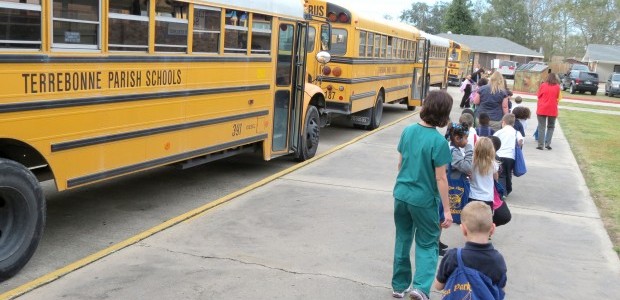
DTB offers creativity in local designs
December 19, 2012
Lafourche OKs $1M for ailing hospital
December 19, 2012Nichole Brauck Robichaux was afraid Friday’s weather would remain chilly, so she showed up at Boudreaux Canal Elementary School with a jacket for her 4-year-old son, Aiden.
“I dropped off his jacket and the first thing I thought when I walked in was how no one had asked me any questions,” said the Chauvin mother of two.
Shortly after returning home, Robichaux saw the first Internet reports of the Newtown, Conn., elementary school shooting that resulted in the loss of 26 lives, 20 of the victims school children between 6 and 7 years of age, and her experience earlier that day took on new significance.
“It definitely scared me because if it could happen there it could happen here,” Robichaux said. “Keep the school door locked so everyone gets a code to open it. There’s a lady at the front office. Take her out and you have access to all the classrooms. While I watched and read I felt my gut tightening up. Suddenly you don’t feel they’re totally as safe as you want them to be. Who knows who is going to walk in?”
Robichaux was not alone. Throughout the Tri-parish region and nationwide, the Newtown tragedy was the topic of conversation at Christmas parties, on local social media accounts and at schools.
Teachers, administrators, law enforcement officials and others who daily deal with tough questions about campus safety and security were talking a lot among each other as well.
Interviews throughout the weekend and early this week make clear that the horror of the Connecticut event will have a future effect on local schools, with officials already checking the plans they have in place while developing ideas to make schools safer.
• In Terrebonne Parish officials are discussing how to finance placing armed guards or deputies at elementary schools.
• In Lafourche, where school officials reviewed safety plans just a week before the Connecticut tragedy, increased use of programs already in place is being examined.
• A planned millage hike in one school district will now likely include plans for financing greater security measures.
When Terrebonne Parish School Board member Roger Dale DeHart heard the first reports from Connecticut Friday he called schools chief Philip Martin, who was already watching the tragedy unfold on a television set.
“He told me he had already called staff together, and sent a memo to all schools to revisit what we have in place, and that staff will be coming up with more preventive safety issues,” said DeHart.
Those discussions continued Monday when Martin spoke with Terrebonne Parish Sheriff Jerry Larpenter and District Attorney Joe Waitz Jr. Meetings with them and Parish President Michel Claudet are being scheduled for later in the week.
“We want to be proactive and this is law enforcement’s worst nightmare, something like that,” Waitz said. “We are keeping our eyes open, we are brainstorming to see what we can do to prevent something like this.”
Officials say they are proud of safety measures already in place. But the Newtown incident was a particular eye-opener because it occurred in a segment of the school system where in many cases there are bigger gaps, the buildings where the youngest and most vulnerable students attend classes.
The elementary schools have emergency plans and drills for many scenarios, but officials acknowledge that the bulk of visible security changes over the years have occurred at the middle and high school level.
Martin said he fully understands the reaction of parents who want to see more done, because he shares their thoughts. The apparent security gap at Boudreaux Canal, he said, is one of many that may exist unnoticed. He is prepared to take calls, he said, from parents who may be more on edge this week.
“Every parent will have those anxieties,” Martin said. “It is our responsibility to react and provide a system that is nothing less than fool-proof. We have to come up with something that significant.”
Security plans and protocols, individually tailored to each school, are largely dependent on what resources are available nearby.
At Dularge Elementary School, for example, teachers and administrators already know that some emergencies could require getting children to a recreation center located next to the school property. They already have keys, know where the light switches are.
That’s part of the evacuation plan. For emergencies where a threat from without is perceived, Dularge and all the other schools in the system have procedures for locking down and keeping children inside. Those measures have been used successfully, Martin and other officials said, when police have sought suspects near schools, or a serious crime was committed nearby.
The challenge for security is greater at Mulberry Elementary, DeHart noted, with its modular building setup. At elementary schools in general, he said, much of the focus has been on coping with parents involved with custody battles, as well as weather issues and fire.
“In the near, near future I can imagine use of metal detectors,” DeHart said. “This tragedy rings a bell. It asks, ‘Is there one campus that falls short, that needs help.’ I don’t think any member sitting on this board would doubt we have a safe school system, but it is never safe enough. I believe we are in very good shape but we fall short in some areas and I think now that this bell has rung we are going to be thinking metal detectors. We already have some surveillance cameras. We need more.”
Martin said he understands the desire for metal detectors and sees their place in the scheme of overall security. But he is already convinced of his first priority.
“Gizmos and gadgets are fine, but this school had all the gadgets and gizmos and it didn’t work,” Martin said. “I have no idea how we are going to pay for this. But I want armed security at every school – that would be my number one preference. These wackos are basically cowards so they don’t do things if there is someone to confront them, armed and better trained than they are.”
Metal detectors serve a purpose, Martin said, and can go a long way toward making parents feel secure. But he questions their value as opposed to the armed presence that he desires.
Terrebonne has already been working on a millage increase. If necessary, Martin said, he will weave plans for increased security into that. But no matter how or where he gets the money, he is already committed to the concept.
“We’ve got to up the ante,” he said. “How much do you think these parents in Connecticut would have paid to prevent this?”
Martin also has no doubt that as the national discussion continues to be fueled by the Connecticut tragedy, money for school safety could emerge through special grants and packages through the Department of Justice or other agencies.
St. Mary Parish assistant superintendent Keith Thibodaux said he has confidence in the current plans at his schools, and that safety is drilled with and without police agencies. But he and other officials were reviewing procedures Monday.
“We are looking at a few things,” he said. “Mostly points of entry within the schools and overall review of the plans.”
St. Mary has resource officers in its schools, though not all of its schools, and no presence in the elementary schools.
“It’s a good idea,” Thibodeaux said of Martin’s focus on an armed presence. “If you can find the money and the staff and work with the agencies to make that work. In our schools where we have used resource officers it does help. That would be a plus.”
In the Lafourche Parish schools, safety director Seth Holloway said grants have already provided security cameras for all schools. A limited number of metal detectors provide extra security for schools, particularly when a specific incident or threat of one looms. They are brought to different schools when the need arises, and sometimes just as an extra precaution.
“We bring them around whether we have something happening or not, randomly at the middle schools and high schools,” Holloway said.
He received several calls from anxious parents Monday, and patiently went over security tools now in place with them.
Each school, he said, has a crisis plan in addition to the one prepared for the district as a whole.
Sheriff Craig Webre worked closely with school officials to direct more help their way with an ongoing improvement program.
So far, out of 28 schools in the Lafourche District, 14 are equipped with a special program that provides a greater measure of security. A computer program at each individual school allows law enforcement and administrators the potential of monitoring multiple areas of the campus inside and out, lists of chemicals stored in labs at some schools, and other information to aid management of an emergency.
In Lafourche, as in Terrebonne, deputies or police officers are not routinely assigned to elementary schools.
Holloway said officers do make stops at elementary schools, however.
“All of our schools are reviewing their plans,” Holloway said. “This is certainly impacting us, although I do believe we are on the cutting edge.”
Lafourche had its own tragedy in 2008, when a disturbed student entered Larose Cut Off Middle School with a gun, threatened a classroom and then took his own life in a rest room.
“This person was a student and didn’t have to get access from outside,” Holloway said. “What we have now in every single school is that when someone is in a class that door is locked. When the teacher is not in class teaching that door is locked. If I go through a school and see they have a door open it is not going to be good for that teacher that day.”
Many of the plans in place for such emergencies were implemented, although there were soft spots in the system that were later critiqued, tweaked and otherwise improved, officials have said.
“What we have learned with schools is that if someone is wanting to get into that facility they are going to get in,” Holloway said. “There is nothing that we can implement that will prevent that.”
That’s one reason, he said, why the idea of an officer stationed at every school could go a long way toward prevention, or minimizing danger if an intrusion did occur.
Further weaknesses in the system, Holloway said, need to be examined on a school-by-school level. At South Thibodaux Middle, he noted, there is a wide-open campus with a road running through the middle of it.
The solution to that, Holloway said, is construction of a new school. But recognizing problems like that, he said, is where the re-evaluations that are now under way can lay the groundwork for change.
Keeping children safer in a post-Sandy Hook world, Martin said, will require administrators, educators and parents to keep open minds.
“We want to look at a short-term and a long-term plan,” he said. “It’s a change of mindset we are going to have to do at all our schools. For years we have preached schools had to be user friendly, parent friendly places. We have to do some things with the security side that may not generate a warm, fuzzy feeling right off the bat. But we do have to do what we have to do.”
Parents, meanwhile, cope with fears for their children while enduring the non-stop blare of news coming from the sad little town in Connecticut, whose tragedy is expected to foment change clear to the doorsteps of the bayous.
“Who knows who is going to walk in to a school?” said Nichole Robichaux, who greeted the return of 4-year-old Aiden from school Monday with a bigger than usual hug. “He had to tell me to stop squeezing him.”
Students at Lisa Park Elementary prepare to board buses at the end of school on Monday.













